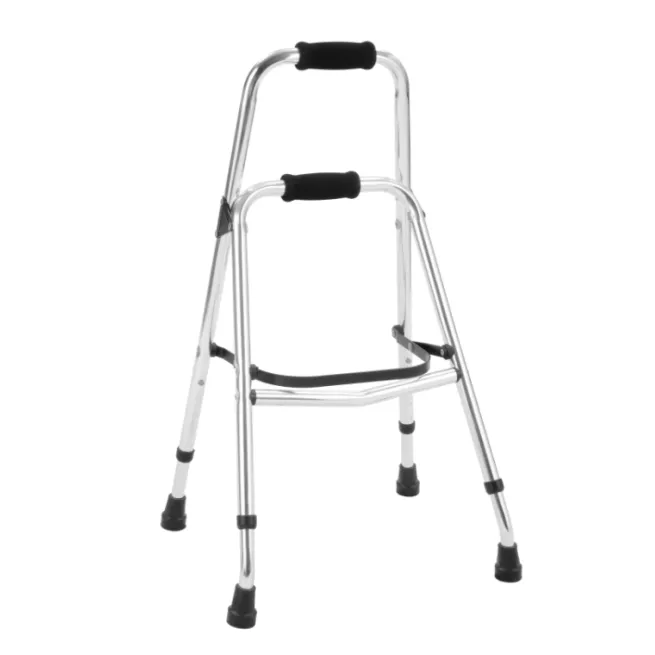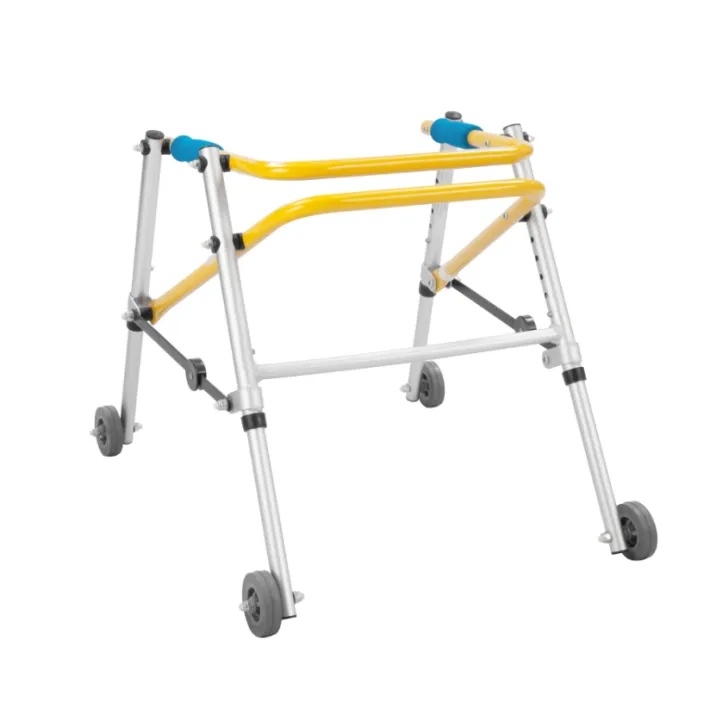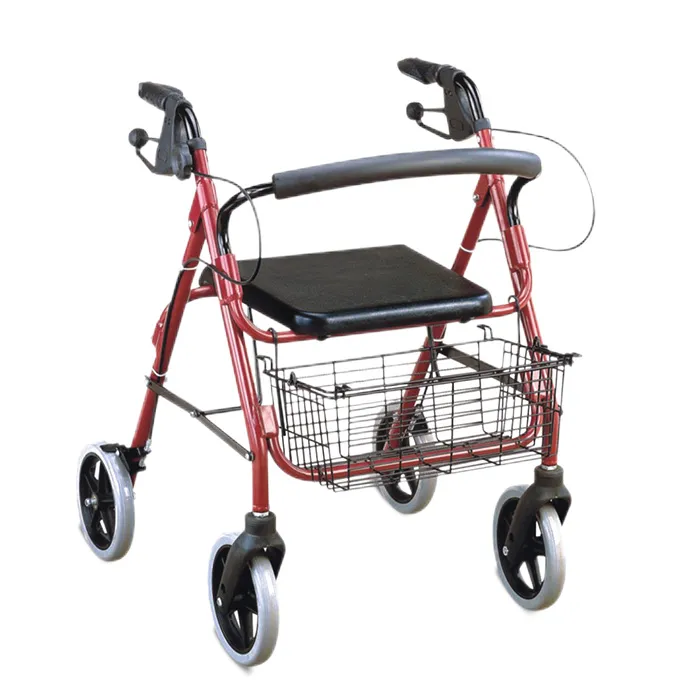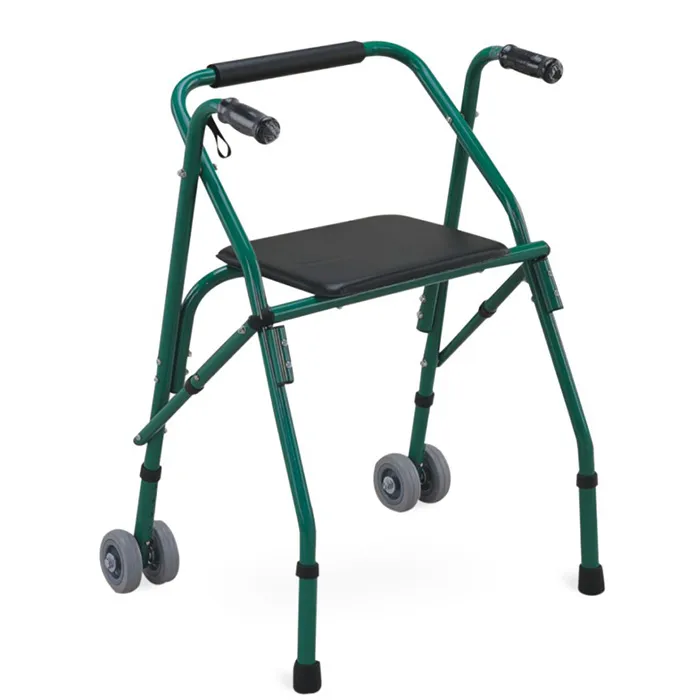Physical changes such as joint degeneration, weakened muscle strength, and reduced balance ability make it difficult for many elderly people to walk, and even prone to safety accidents such as falls. In response to this phenomenon, various types of mobility aids have emerged, among which the "elderly walking frame" has become one of the most common and effective assistive devices.
This article will focus on the theme of "elderly walking frame" and deeply analyze the definition, structure, classification, function, applicable population, and precautions of walking frame to help the public fully understand what an elderly walking frame is, why it is so important for the elderly, and how to correctly choose and use this assistive tool.

What is an elderly walking frame?
Elderly walking frame is a walking aid designed for people with limited mobility, mainly used to enhance the user's stability, support and walking ability. It provides additional contact points, shares body weight, and assists the elderly to maintain balance, so that they can complete daily walking activities safely and stably.
For the elderly, the role of walking frame is not only reflected in physical support, but more importantly, it provides walking confidence and the ability to move independently, delays the time of dependence on others, and improves the quality of life and dignity.
What are the structural components of the elderly walking frame?
The design concept of the elderly walking frame is "safety, support, and convenience", and its structure is highly functional and humanized. A typical walking frame is mainly composed of the following parts:
1. Support frame
This is the main part of the elderly walking frame, usually made of lightweight materials such as aluminum alloy, stainless steel or carbon fiber, which ensures strength and reduces overall weight. The frame height is adjustable to meet the needs of elderly people of different heights.
2. Handles and armrests
The handles are the most frequent contact parts between the elderly and the walking frame. They are usually wrapped with anti-slip materials and designed in an ergonomic way to reduce grip fatigue, increase friction, and improve control stability.
3. Base support structure (wheels or foot pads)
Depending on the purpose and design, the elderly walking frame can be equipped with different forms of bottom structures. Common forms include wheelless foot pads, two wheels, four wheels, etc., providing different degrees of mobility convenience and support performance.
4. Brake device (applicable to wheeled walking frames)
In order to ensure safety during walking, some walking frames are equipped with manual or automatic brake systems. Users can easily operate the brakes to prevent the walking frame from sliding and ensure that no accidents occur when standing or resting.
5. Auxiliary components (seats, storage baskets, folding functions)
In order to enhance the convenience and comfort of use, some elderly walking frames will also be equipped with foldable seats, shopping baskets, backpacks or adjustable backrests to improve the practicality of the product and meet the diverse needs of users when going out.

What are the main categories of elderly walking frames?
Main categories of elderly walking frames:
1. Fixed walking frame
2. Front wheel walking frame
3. Four-wheel walking frame (with brakes)
4. Folding walking frame
5. Electric walking frame (not the focus of this article)
According to the different mobility and usage scenarios of the elderly, rolling walkers for seniors can be divided into 5 categories, each with its own characteristics and applicable population.
1. Fixed walking frame
This type of elderly walking frame has no wheels at the bottom and only consists of four legs. Users need to move gradually through the three steps of "lift-move forward-support". This type of walking frame has high stability and is suitable for users with extremely weak leg strength and need to focus on support, but the movement efficiency is low.
2. Front wheel walking frame
Wheels are installed on the front two feet, and rubber pads are kept at the back. Users only need to lift the back feet slightly to move forward easily, reducing lifting movements and physical exertion. Suitable for elderly people with certain leg strength but slow movements.
3. Four-wheel walking frame (with brakes)
Equipped with four wheels, usually with a brake system, flexible operation and smooth pushing. Some models also have additional functions such as seats, backrests, and storage baskets. This type is suitable for elderly people who can walk independently but need support and rest, especially for long-term outdoor walking.
4. Folding walking frame
In order to facilitate storage and carrying, many elderly walking frames adopt a folding design. Folding walking frames are convenient for the elderly to go up and down stairs and store when riding in a car. They are suitable for users who need to go out frequently.
5. Electric walking frames
Some high-end walking frames have electric drive functions to further reduce physical burden, but they are expensive and do not belong to the common category of popular elderly walking frames.

What is the role of elderly walking frames?
Rolling walkers for seniors are not just a simple support tool. Their functions cover multiple dimensions: enhancing body balance, sharing the weight-bearing pressure of lower limbs, preventing falls, improving safety, improving independent walking ability, and enhancing psychological confidence and life dignity.
1. Enhance body balance
With age, the vestibular system, vision, and muscle control of the human body decline, which can easily lead to imbalance. Elderly walking frames provide users with external support points through multi-point support to help them restore body stability.
2. Sharing the weight-bearing pressure of lower limbs
During knee and hip joint damage or postoperative rehabilitation, elderly walking frames can transfer part of the body weight from the lower limbs to the upper limbs, relieve lower limb pressure, reduce pain, and promote recovery.
3. Prevent falls and improve safety
Falls are one of the important causes of casualties among the elderly. The use of elderly walking frames can effectively prevent falls and improve the safety factor during walking.
4. Improve independent walking ability
With the help of walking frames, the elderly can restore a certain degree of independent mobility, without relying on the support of others, and can complete basic daily activities such as shopping and walking on their own.
5. Enhance psychological confidence and life dignity
The physical support and sense of security brought by the use of elderly walking frames can effectively improve the elderly's life confidence and emotional state, prolong their life autonomy and participation in social activities.
Who are the suitable groups for walking frames?
Although walking frames are mainly designed for the elderly, their applicable objects have clear indications:
● People with mild to moderate mobility impairments;
● Patients in the recovery period after fractures and joint replacements;
● Elderly people with decreased muscle strength and unstable gait;
● Groups with weak lower limb control due to stroke or neurological degeneration;
● People who feel tired after standing or walking for a long time but do not rely on wheelchairs.
It should be noted that patients with severe cognitive impairment or poor coordination should undergo professional evaluation before using the elderly walking frame to ensure its safe use.

How to use the elderly walking frame correctly?
Although the elderly walking frame has a simple structure, it may still pose hidden dangers if used improperly. Therefore, it is particularly important to master the correct way of use:
1. Adjust the appropriate height
The height of the elderly walking frame should be flush with the user's wrist, and the hands should be naturally hanging when standing, with the elbows slightly bent (about 15-20 degrees) to facilitate pushing and support.
2. Hold the walking frame with both hands and push it
When using the elderly walking frame, you need to hold the handrails tightly with both hands, keep your body centered, and do not lean to either side to avoid imbalance or tilt due to unilateral force.
3. Gait coordination and slow advancement
When walking, you should first place the walking frame firmly in front, then step forward, make sure your steps keep up with the position of the walking frame, and maintain a coordinated rhythm.
4. Pay attention to the ground conditions
Users should avoid walking on slippery, gravel, or uneven roads; when crossing steps or obstacles, they should seek help from others and avoid taking risks alone.
5. Lock the brakes before sitting down or resting (applicable to walking frames with brakes)
When using a walking frame with a seat, the wheel brakes must be locked before sitting down to prevent the walking frame from sliding and causing falls.
How can I buy wholesale wheelchairs directly from your company?
To buy wheelchairs wholesale, simply contact our sales team for quotes, discounts, and catalog. Yikang Medical supplies standard, foldable, and lightweight wheelchairs for different usage scenarios, including hospitals, elderly homes, and rehabilitation centers. Our factory in China ensures efficient production and cheap prices without compromising on quality. We offer global shipping, support custom branding, and provide wholesale pricing for large orders.

